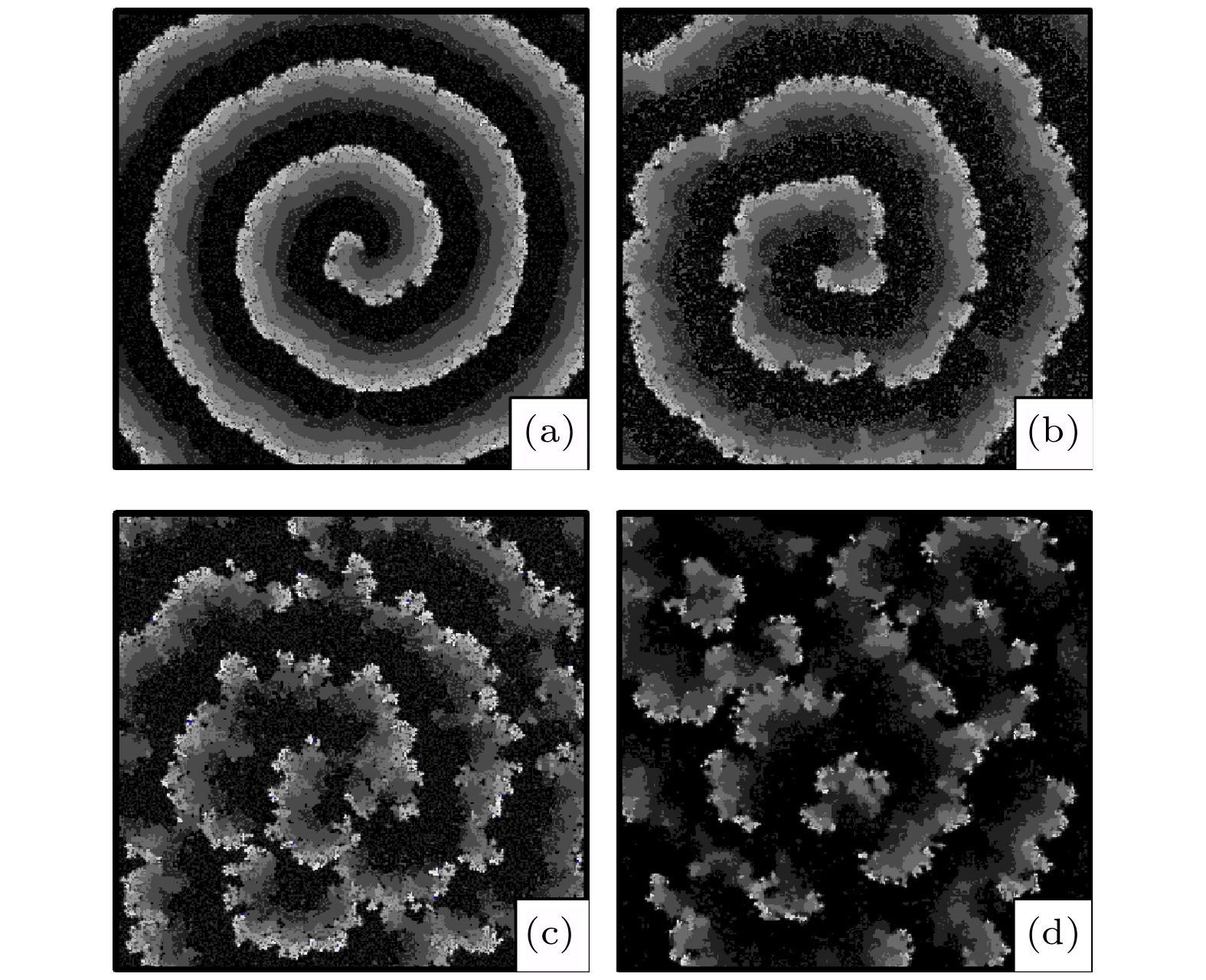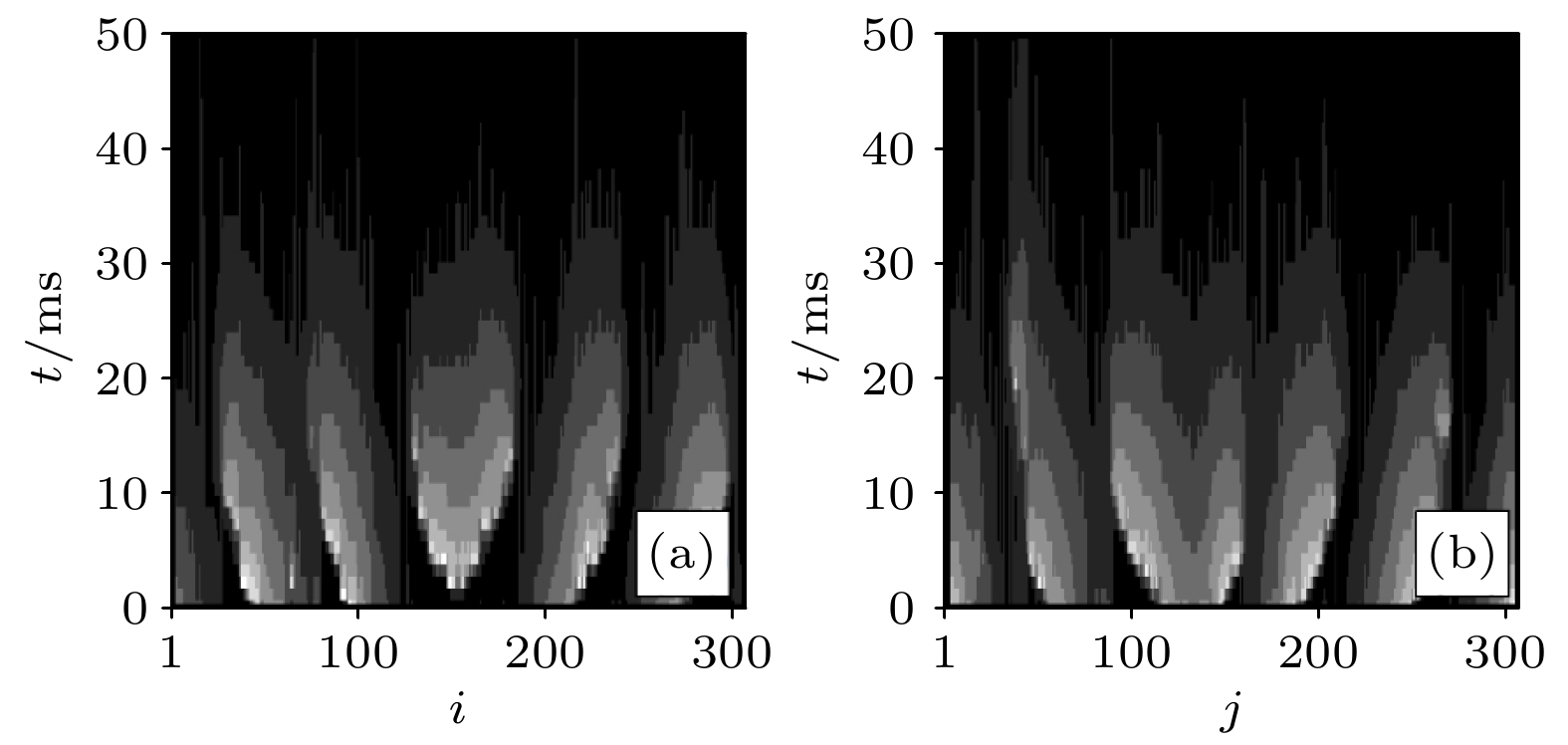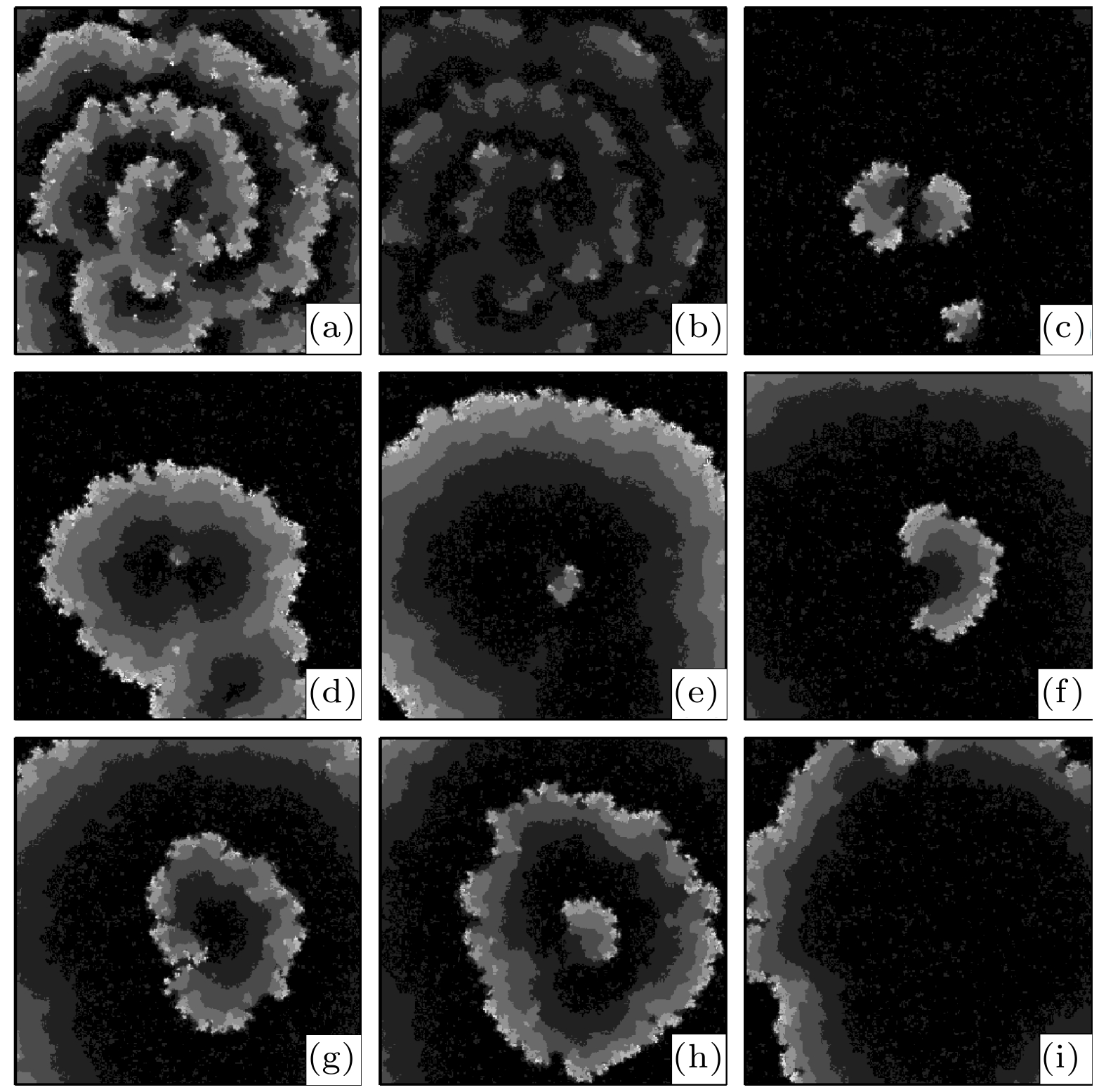-
Cardiac arrhythmias can be caused by the occurrence of electrical spiral waves and spatiotemporal chaos in the cardiac tissues, as well as by the changes of cardiac tissues resulting from the electrical coupling of cardiomyocytes to fibroblasts (M-F coupling). How to control the arrhythmia induced by spiral wave or spatiotemporal chaos is the problem which has attracted much attention of scientists. In this paper, a two-layer composite medium is constructed by using cardiomyocytes and fibroblasts. Luo-Rudy phase I cardiac model and passive model of fibroblast are used to study the effects of the M-F coupling on the formation of spiral wave and the control of spiral wave and spatiotemporal chaos in a two-layer composite medium. A control scheme that the spiral waves and spatiotemporal chaos are controlled by increasing the coupling strength between cells is proposed. The numerical results show that the M-F coupling has an important influence on the dynamics of spiral wave. With the increase of the density of fibroblasts, the M-F coupling may result in spiral wave meandering and spiral wave breaking into spatiotemporal chaos, and even induce the transition from spatiotemporal chaos (or spiral wave) to no wave. The eliminating spiral wave and spatiotemporal chaos in the composite medium by increasing the coupling strength between cells is only effective in most of cases, depending on the role played by fibroblasts. When fibroblasts act as current sinks for the cardiomyocyte, the spiral wave and spatiotemporal chaos are effectively eliminated only in most of cases by increasing the coupling strength between cells, and the controlled area is small. When fibroblasts act as a current source for the cardiomyocyte, increasing the coupling strength between cells to a value higher than a critical value can effectively terminate spiral wave and spatiotemporal chaos, and the controllable area is greatly increased compared with the former. Increasing the coupling strength between cardiomyocytes is a key factor in controlling the spiral waves and spatiotemporal chaos.
-
Keywords:
- spiral wave /
- spatiotemporal chaos /
- electrical coupling of cardiomyocytes to fibroblasts /
- control
[1] Johnson R D, Camelliti P 2018 Int. J. Mol. Sci. 19 866
 Google Scholar
Google Scholar
[2] Camelliti P, Borg T K, Kohl P 2005 Cardiovasc. Res. 65 40
 Google Scholar
Google Scholar
[3] Greisas A, Zlochiver S 2016 Cardiovasc. Eng. Techn. 7 290
 Google Scholar
Google Scholar
[4] Sachse F B, Moreno A P, Abildskov J A 2008 Ann. Biomed. Eng. 36 41
 Google Scholar
Google Scholar
[5] Peters N S, Wit A L 1998 Circulation 97 1746
 Google Scholar
Google Scholar
[6] Jacquemet V, Henriquez C S 2008 Am. J. Physiol. Heart Circ. Physiol. 294 H2040
 Google Scholar
Google Scholar
[7] Xie Y F, Garfinkel A, Weiss J N, Qu Z L 2009 Am. J. Physiol. Heart Circ. Physiol. 297 H775
 Google Scholar
Google Scholar
[8] Nguyen T P, Xie Y F, Garfinkel A, Qu Z L, Weiss J N 2012 Cardiovasc. Res. 93 242
 Google Scholar
Google Scholar
[9] Brown T R, Krogh-Madsen T, Christini D J 2015 BioMed. Res. Int. 2015 465714
 Google Scholar
Google Scholar
[10] Chilton L, Giles W R, Smith G L 2007 J. Physi. 583 225
 Google Scholar
Google Scholar
[11] Louault C, Benamer N, Faivre J F, Potreau D, Bescond J 2008 BBA-Biomembranes 1778 2097
 Google Scholar
Google Scholar
[12] Vasquez C, Mohandas P, Louie K L, Benamer N, Bapat A C, Morley G E 2010 Circulation Research 107 1011
 Google Scholar
Google Scholar
[13] Baudino T A, McFadden A, Fix C, Hastings J, Price R, Borg T K 2008 Microsc. Microanal. 14 117
 Google Scholar
Google Scholar
[14] Shajahan T K, Nayak A R, Pandit R 2009 Plos One 4 e4738
 Google Scholar
Google Scholar
[15] Nayak A R, Shajahan T K, Panfilov A V, Pandit R 2013 Plos One 8 e72950
 Google Scholar
Google Scholar
[16] Kofron C M, Kim T Y, King M E, Xie A, Feng F, Park E, Qu Z, Choi B R, Mende U 2017 Am. J. Physiol. Heart Circ. Physiol. 313 H810
 Google Scholar
Google Scholar
[17] Kohl P, Camelliti P, Burton F L, Smith G L 2005 J. Electrocardiol 38 45
 Google Scholar
Google Scholar
[18] Luo C H, Rudy Y 1991 Circ. Res. 68 1501
 Google Scholar
Google Scholar
-
图 1 不同参数下在
$\rho \text{-} n$ 参数平面上的相图(■代表稳定螺旋波; ●代表漫游单螺旋波; ◆代表不稳定螺旋波; ▼代表时空混沌态; ▲代表介质无波) (a)$ {G}_{\rm{f}}=1\;{\rm{ns}}$ ,${G}_{\rm{gap}}= $ $ 3\;{\rm{ns}}$ ; (b)$ {G}_{\rm{f}}=4\;{\rm{ns}}$ ,$ {G}_{\rm{gap}}=1\;{\rm{ns}}$ Figure 1. Phase diagrams on the
$\rho \text{-} n$ parameter plane with different parameters: (a)$ {G}_{\rm{f}}=1\;{\rm{ns}}$ ,$ {G}_{\rm{gap}}=3\;{\rm{ns}}$ ; (b)${G}_{\rm{f}}= $ $ 4\;{\rm{ns}}$ ,$ {G}_{\rm{gap}}=1\;{\rm{ns}}$ . Black square, stable spiral wave; black circle, meandering of single spiral wave; black rhombus, unstable spiral wave; black down-triangle, spatiotemporal chaos; black up-triangle, no wave can propagate in the medium.图 2 不同参数下其中一层心肌层的螺旋波斑图 (a)
${G}_{\rm{f}}= $ $ 4\;{\rm{ns}}$ ,$ {G}_{\rm{gap}}=1\;{\rm{ns}}$ ,$\rho = 20{\text{%}}$ ,$n = {\rm{1}}$ ; (b)$ {G}_{\rm{f}}=4\;{\rm{ns}}$ ,$ {G}_{\rm{gap}}=1\;{\rm{ns}}$ ,$\rho = 30{\text{%}}$ ,$n = {\rm{3}}$ ; (c)$ {G}_{\rm{f}}=4\;{\rm{ns}}$ ,$ {G}_{\rm{gap}}=1\;{\rm{ns}}$ ,$\rho = 40{\text{%}}$ ,$n = {\rm{2}}$ ; (d)$ {G}_{\rm{f}}= $ $ 1\;{\rm{ns}}$ ,$ {G}_{\rm{gap}}=3\;{\rm{ns}}$ ,$\rho = {\rm{4}}0{\text{%}}$ ,$n = $ 4Figure 2. Pattern of spiral wave in one layer cardiac tissue for different parameters: (a)
$ {G}_{\rm{f}}=4\;{\rm{ns}}$ ,$ {G}_{\rm{gap}}=1\;{\rm{ns}}$ ,$\rho = 20{\text{%}}$ ,$n = {\rm{1}}$ ; (b)$ {G}_{\rm{f}}=4\;{\rm{ns}}$ ,$ {G}_{\rm{gap}}=1\;{\rm{ns}}$ ,$\rho = 30{\text{%}}$ ,$n = {\rm{3}}$ ; (c)${G}_{\rm{f}}= 4\;{\rm{ns}}$ ,$ {G}_{\rm{gap}}=1\;{\rm{ns}}$ ,$\rho = 40{\text{%}}$ ,$n = {\rm{2}}$ ; (d)${G}_{\rm{f}}= $ $ 1 \;{\rm{ns}}$ ,$ {G}_{\rm{gap}}=3\;{\rm{ns}}$ ,$\rho = {\rm{4}}0{\text{%}}$ ,$n = {\rm{4}}$ .图 3 不同参数下成纤维细胞静息电位随时间变化 (a)
${G_{\rm{f}}} = 1\;{\rm{ns}}$ ,${G_{{\rm{gap}}}} = 3\;{\rm{ns}}$ ,$n = 2$ ,$\rho = 30{\text{%}}$ ; (b)${G_{\rm{f}}} = 1\;{\rm{ns}}$ ,${G_{{\rm{gap}}}} = 3\;{\rm{ns}}$ ,$n = 5$ ,$\rho = 30{\text{%}}$ ; (c)${G_{\rm{f}}} = 4\;{\rm{ns}}$ ,${G_{{\rm{gap}}}} = 1\;{\rm{ns}}$ ,$n = 2$ ,$\rho = 30{\text{%}}$ ; (d)${G_{\rm{f}}} = 4\;{\rm{ns}}$ ,${G_{{\rm{gap}}}} = 1\;{\rm{ns}}$ ,$n = 5$ ,$\rho = 30{\text{%}}$ Figure 3. Evolution of the resting potential of a fibroblast for different control parameters: (a)
${G_{\rm{f}}} = 1\;{\rm{ns}}$ ,${G_{{\rm{gap}}}} = 3\;{\rm{ns}}$ ,$n = 2$ ,$\rho = 30{\text{%}}$ ; (b)${G_{\rm{f}}} = 1\;{\rm{ns}}$ ,${G_{{\rm{gap}}}} = 3\;{\rm{ns}}$ ,$n = 5$ ,$\rho = 30{\text{%}}$ ; (c)${G_{\rm{f}}} = 4\;{\rm{ns}}$ ,${G_{{\rm{gap}}}} = 1\;{\rm{ns}}$ ,$n = 2$ ,$\rho = 30{\text{%}}$ ; (d)${G_{\rm{f}}} = 4\;{\rm{ns}}$ ,${G_{{\rm{gap}}}} = 1\;{\rm{ns}}$ ,$n = 5$ ,$\rho = 30{\text{%}}$ .图 4 与图1(a)对应的各初态下在
$D \text{-} {G_{{\rm{gap}}}}$ 参数平面上的相图, 其中, 第1行到第4行各图参数分别对应$\rho = $ 10%, 20%, 30%, 40%; 第1列到第5列各图参数分别对应$n = 1, \;2, \;3, \;4, \;5$ ; ■代表不可控, Δ代表慢可控, □代表快可控Figure 4. Phase diagram in the
$D \text{-} {G_{{\rm{gap}}}}$ parameter plane for different initial states showed in Fig. 1(a). The parameter$\rho $ of the panels from the first row to the fourth row equals to 10%, 20%, 30%, 40%, respectively. The parameter$n$ of the panels from the first column to the fifth column equals to 1, 2, 3, 4, 5, respectively. Black and hollow squares represent the uncontrolled point and fast control point, respectively. Hollow up-triangle represents the slow control point.图 5 与图1(b) 对应的各初态下在
$D \text{-} {G_{{\rm{gap}}}}$ 参数平面上的相图, 其中, 第1行到第4行各图参数分别对应$\rho =$ 10%, 20%, 30%, 40%; 第1列到第5列各图参数分别对应$n = 1, \;2, \;3, \;4, \;5$ ; ■代表不可控, Δ代表慢可控, □代表快可控Figure 5. Phase diagram in the
$D \text{-} {G_{{\rm{gap}}}}$ parameter plane for different initial states showed in Fig. 1(b). The parameter$\rho $ of the panels from the first row to the fourth row equals to 10%, 20%, 30%, 40%, respectively. The parameter$n$ of the panels from the first column row to the fifth column equals to 1, 2, 3, 4, 5, respectively. Black and hollow squares represent the uncontrolled point and fast control point, respectively. Hollow up-triangle represents the slow control point.图 6 在不同的初态斑图和控制参数下平均膜电位差随时间的变化 (a)初态为图2(b),
$D = 0{\rm{.004}}\;{\rm{c}}{{\rm{m}}^2}/{\rm{ms}}$ ,${G_{{\rm{gap}}}} = {\rm{10\; ns}}$ ; (b)初态为图2(a),$D = 0{\rm{.003}}\;{\rm{c}}{{\rm{m}}^2}/{\rm{ms}}$ ,${G_{{\rm{gap}}}} = $ $ {\rm{10\; ns}}$ ; (c)初态为图2(c),$D = 0{\rm{.004}}\;{\rm{c}}{{\rm{m}}^2}/{\rm{ms}}$ ,${G_{{\rm{gap}}}} = {\rm{12\; ns}}$ Figure 6. Evolution of the average membrane potential difference for different control parameters and initial states: (a) The initial state is shown in Fig. 2(b),
$D = 0{\rm{.004}}\;{\rm{c}}{{\rm{m}}^2}/{\rm{ms}}$ ,${G_{{\rm{gap}}}} = {\rm{10\; ns}}$ ; (b) the initial state is shown in Fig. 2(a),$D = 0{\rm{.003}}\;{\rm{c}}{{\rm{m}}^2}/{\rm{ms}}$ ,${G_{{\rm{gap}}}} = {\rm{10\; ns}}$ ; (c) the initial state is shown in Fig. 2(c),$D = 0{\rm{.004}}\;{\rm{c}}{{\rm{m}}^2}/{\rm{ms}}$ ,${G_{{\rm{gap}}}} = {\rm{12\; ns}}$ .图 8 在图6(b)参数下不同时刻的膜电位斑图 (a)
$t = $ $ {\rm{10\; ms}}$ ; (b)$t = {\rm{40\; ms}}$ ; (c)$t = {\rm{8}}0\;{\rm{ms}}$ ; (d)$t = {\rm{12}}0\;{\rm{ms}}$ ; (e)$t = $ $ {\rm{18}}0\;{\rm{ms}}$ ; (f)$t = {\rm{22}}0\;{\rm{ms}}$ ; (g)$t = {\rm{32}}0\;{\rm{ms}}$ ; (h)$t = {\rm{38}}0\;{\rm{ms}}$ ; (i)$t = {\rm{44}}0\;{\rm{ms}}$ Figure 8. Pattern of membrane potential at different time moments for the parameters corresponding to Fig. 6(b): (a)
$t = $ $ {\rm{10\; ms}}$ ; (b)$t = {\rm{40\; ms}}$ ; (c)$t = {\rm{8}}0\;{\rm{ms}}$ ; (d)$t = {\rm{12}}0\;{\rm{ms}}$ ; (e)$t = $ $ {\rm{18}}0\;{\rm{ms}}$ ; (f)$t = {\rm{22}}0\;{\rm{ms}}$ ; (g)$t = {\rm{32}}0\;{\rm{ms}}$ ; (h)$t = {\rm{38}}0\;{\rm{ms}}$ ; (i)$t = {\rm{44}}0\;{\rm{ms}}$ .图 9 在图6(c)参数不同时刻的膜电位斑图 (a)
$t = $ $ {\rm{1}}0\;{\rm{ms}}$ ; (b)$t = {\rm{30\; ms}}$ ; (c)$t = {\rm{8}}0\;{\rm{ms}}$ ; (d)$t = {\rm{11}}0\;{\rm{ms}}$ ; (e)$t = $ $ {\rm{14}}0\;{\rm{ms}}$ ; (f)$t = {\rm{17}}0\;{\rm{ms}}$ ; (g)$t = {\rm{26}}0\;{\rm{ms}}$ ; (h)$t = {\rm{36}}0\;{\rm{ms}}$ ; (i)$t = {\rm{48}}0\;{\rm{ms}}$ Figure 9. Pattern of membrane potential at different time moments for the parameters corresponding to Fig. 6(c): (a)
$t = $ $ {\rm{1}}0\;{\rm{ms}}$ ; (b)$t = {\rm{30\; ms}}$ ; (c)$t = {\rm{8}}0\;{\rm{ms}}$ ; (d)$t = {\rm{11}}0\;{\rm{ms}}$ ; (e)$t = $ $ {\rm{14}}0\;{\rm{ms}}$ ; (f)$t = {\rm{17}}0\;{\rm{ms}}$ ; (g)$t = {\rm{26}}0\;{\rm{ms}}$ ; (h)$t = {\rm{36}}0\;{\rm{ms}}$ ; (i)$t = {\rm{48}}0\;{\rm{ms}}$ . -
[1] Johnson R D, Camelliti P 2018 Int. J. Mol. Sci. 19 866
 Google Scholar
Google Scholar
[2] Camelliti P, Borg T K, Kohl P 2005 Cardiovasc. Res. 65 40
 Google Scholar
Google Scholar
[3] Greisas A, Zlochiver S 2016 Cardiovasc. Eng. Techn. 7 290
 Google Scholar
Google Scholar
[4] Sachse F B, Moreno A P, Abildskov J A 2008 Ann. Biomed. Eng. 36 41
 Google Scholar
Google Scholar
[5] Peters N S, Wit A L 1998 Circulation 97 1746
 Google Scholar
Google Scholar
[6] Jacquemet V, Henriquez C S 2008 Am. J. Physiol. Heart Circ. Physiol. 294 H2040
 Google Scholar
Google Scholar
[7] Xie Y F, Garfinkel A, Weiss J N, Qu Z L 2009 Am. J. Physiol. Heart Circ. Physiol. 297 H775
 Google Scholar
Google Scholar
[8] Nguyen T P, Xie Y F, Garfinkel A, Qu Z L, Weiss J N 2012 Cardiovasc. Res. 93 242
 Google Scholar
Google Scholar
[9] Brown T R, Krogh-Madsen T, Christini D J 2015 BioMed. Res. Int. 2015 465714
 Google Scholar
Google Scholar
[10] Chilton L, Giles W R, Smith G L 2007 J. Physi. 583 225
 Google Scholar
Google Scholar
[11] Louault C, Benamer N, Faivre J F, Potreau D, Bescond J 2008 BBA-Biomembranes 1778 2097
 Google Scholar
Google Scholar
[12] Vasquez C, Mohandas P, Louie K L, Benamer N, Bapat A C, Morley G E 2010 Circulation Research 107 1011
 Google Scholar
Google Scholar
[13] Baudino T A, McFadden A, Fix C, Hastings J, Price R, Borg T K 2008 Microsc. Microanal. 14 117
 Google Scholar
Google Scholar
[14] Shajahan T K, Nayak A R, Pandit R 2009 Plos One 4 e4738
 Google Scholar
Google Scholar
[15] Nayak A R, Shajahan T K, Panfilov A V, Pandit R 2013 Plos One 8 e72950
 Google Scholar
Google Scholar
[16] Kofron C M, Kim T Y, King M E, Xie A, Feng F, Park E, Qu Z, Choi B R, Mende U 2017 Am. J. Physiol. Heart Circ. Physiol. 313 H810
 Google Scholar
Google Scholar
[17] Kohl P, Camelliti P, Burton F L, Smith G L 2005 J. Electrocardiol 38 45
 Google Scholar
Google Scholar
[18] Luo C H, Rudy Y 1991 Circ. Res. 68 1501
 Google Scholar
Google Scholar
Catalog
Metrics
- Abstract views: 8293
- PDF Downloads: 94
- Cited By: 0



























 DownLoad:
DownLoad:


















































































































































